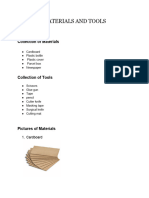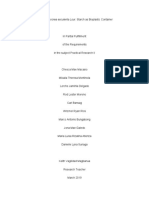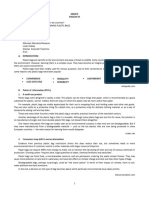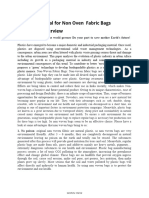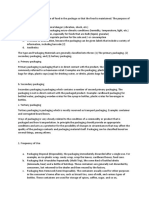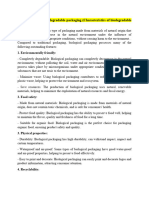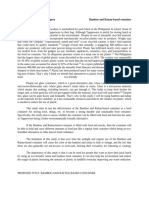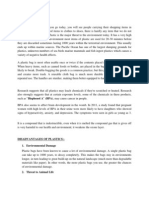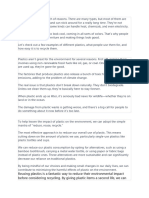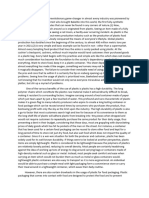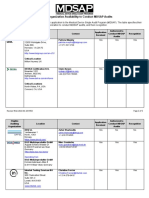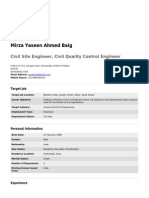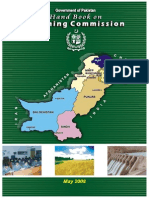The Age of Plastic
The Age of Plastic
Uploaded by
dharvi07gargCopyright:
Available Formats
The Age of Plastic
The Age of Plastic
Uploaded by
dharvi07gargCopyright
Available Formats
Share this document
Did you find this document useful?
Is this content inappropriate?
Copyright:
Available Formats
The Age of Plastic
The Age of Plastic
Uploaded by
dharvi07gargCopyright:
Available Formats
The Age of Plastic-Why we need to change
Traditional Packaging Materials vs. Current Packaging Materials
1. Toothpaste:
o Traditional Packaging:
Material: Metal tubes (often made from tin or aluminium).
Reason: Metal tubes were durable and could keep the toothpaste fresh.
o Current Packaging:
Material: Plastic tubes (often made from multi-layered plastics).
Reason: Plastic is cheaper, lightweight, and easier to produce in various sizes.
2. Soap:
o Traditional Packaging:
Material: Paper wraps or cardboard boxes.
Reason: Paper and cardboard are biodegradable and can protect soap from contamination.
o Current Packaging:
Material: Plastic wraps or containers.
Reason: Plastic provides better moisture resistance and can be moulded into various shapes.
3. Shampoo:
o Traditional Packaging:
Material: Glass bottles.
Reason: Glass is impermeable and preserves the product without chemical interaction.
o Current Packaging:
Material: Plastic bottles.
Reason: Plastic bottles are lighter, less prone to breakage, and cheaper to transport.
4. Body Scrubbers:
o Traditional Packaging:
Material: Natural materials like loofah, packed in paper.
Reason: Loofahs are biodegradable and paper is environmentally friendly.
o Current Packaging:
Material: Synthetic materials (like nylon) and plastic packaging.
Reason: Synthetic materials are durable, and plastic packaging is water-resistant.
The Rise of Plastic Packaging
When and How Plastics Replaced Traditional Materials:
1940s-1950s: The development of polyethylene and other plastics during WWII led to
a surge in plastic production. Post-war, plastics were marketed as versatile and
superior to traditional materials.
1960s-1970s: Increased production capabilities and the rise of consumerism saw
plastics become the go-to material for packaging due to their cost-effectiveness and
versatility.
1980s-Present: Advances in plastic manufacturing technologies have made it
possible to create a wide range of plastic packaging, further embedding plastic in
everyday life.
Environmental Impact of Plastic Packaging
1. Waste Accumulation:
o Plastic waste is non-biodegradable and accumulates in landfills and oceans,
causing long-term pollution.
2. Wildlife Harm:
o Animals ingest or get entangled in plastic waste, leading to injuries or death.
3. Resource Depletion:
o Plastics are made from petrochemicals, depleting non-renewable resources.
4. Chemical Pollution:
o Plastics release harmful chemicals during production and degradation,
affecting ecosystems and human health.
Why We Need to Change
1. Sustainability:
o Shifting to biodegradable and sustainable materials reduces environmental
footprint.
2. Resource Conservation:
o Using renewable resources for packaging helps conserve non-renewable
resources.
3. Health Benefits:
o Reducing plastic use lowers exposure to harmful chemicals associated with
plastic production and degradation.
4. Waste Reduction:
o Biodegradable and recyclable materials help in managing waste more
effectively.
References
1. Environmental Protection Agency (EPA)
2. World Wildlife Fund (WWF)
3. National Geographic
4. History of Packaging by the Packaging History Institute
5. Plastic Pollution Coalition
You might also like
- TOS in Math 8 2nd GradingDocument5 pagesTOS in Math 8 2nd Gradingchristine may felia100% (1)
- Food Packaging Wastes and Environmental ImpactsDocument5 pagesFood Packaging Wastes and Environmental ImpactsavtaskovNo ratings yet
- Food PackagingDocument10 pagesFood Packagingyasmine.zamoum8No ratings yet
- Report On Plastic BagsDocument2 pagesReport On Plastic BagsQuỳnh DoãnNo ratings yet
- Efficiency of Using Eco-Bag Instead of Plastic Bags in Hagonoy in Coping Environmental IssuesDocument11 pagesEfficiency of Using Eco-Bag Instead of Plastic Bags in Hagonoy in Coping Environmental IssuesGlenn ClementeNo ratings yet
- Paper vs. PlasticDocument29 pagesPaper vs. PlasticCari BalboaNo ratings yet
- Materials and ToolsDocument15 pagesMaterials and Toolsmansimanoj2005No ratings yet
- Research Draft 2.2Document4 pagesResearch Draft 2.2shariagmamergaNo ratings yet
- Title: Biodegradable Plastic Making at Home Project Report: What Is Plastic or Planet?Document5 pagesTitle: Biodegradable Plastic Making at Home Project Report: What Is Plastic or Planet?BAIGPRONo ratings yet
- Plastic Group 1Document20 pagesPlastic Group 1DELA TORRE KAREN KAYE PABLEONo ratings yet
- Regulation of Plastic Bags in The Philippines and Other CountriesDocument47 pagesRegulation of Plastic Bags in The Philippines and Other Countriesmendozajuliemae181996No ratings yet
- Plastic - Docx - As Revised After ValidationDocument47 pagesPlastic - Docx - As Revised After ValidationMark RiveraNo ratings yet
- Plastic Waste ManagementDocument11 pagesPlastic Waste ManagementvashigvanNo ratings yet
- Baong Dioscorea Esculenta Lour Starch As Bioplastic ContainerDocument25 pagesBaong Dioscorea Esculenta Lour Starch As Bioplastic ContainerAdhaNo ratings yet
- Business Studies ProjectDocument10 pagesBusiness Studies ProjectKritarth AgarwalNo ratings yet
- Food PackagingDocument13 pagesFood PackagingPshtiwan SaidNo ratings yet
- IntroductionDocument3 pagesIntroductionKaseh DhaahNo ratings yet
- Debate For EnglishDocument2 pagesDebate For EnglishemmanuelbergadounoofficialiiiNo ratings yet
- Detailed Project Report-RawDocument21 pagesDetailed Project Report-RawRishad AhmedNo ratings yet
- Thesis Bioplastic 2Document18 pagesThesis Bioplastic 2Annalie LobianoNo ratings yet
- Plastic-Boon or CurseDocument1 pagePlastic-Boon or CurseDivya Gade67% (3)
- Sustainable PackagingDocument11 pagesSustainable Packagingneha.menon.2005No ratings yet
- EN12 Research ProspectusDocument14 pagesEN12 Research Prospectuskaren.tomas94No ratings yet
- Natural Resources - Plastic Ban in IndiaDocument15 pagesNatural Resources - Plastic Ban in IndiaSakshi DhapodkarNo ratings yet
- Plastic PollutionDocument5 pagesPlastic PollutionVernie N. PiamonteNo ratings yet
- English Foods 1Document3 pagesEnglish Foods 1lintangNo ratings yet
- Agoo Montessori Learning Center and High School Inc.: Fruit Waste As Biodegradable PlasticDocument6 pagesAgoo Montessori Learning Center and High School Inc.: Fruit Waste As Biodegradable PlasticAlejandro De la GarzaNo ratings yet
- CH 46Document11 pagesCH 46Nadya SafitriNo ratings yet
- The Use of Gelatin-Based Bioplastic and Paper As A Dual-Layered Packaging As An Alternative To Sachet Packaging For Powdered Foods and DrinksDocument6 pagesThe Use of Gelatin-Based Bioplastic and Paper As A Dual-Layered Packaging As An Alternative To Sachet Packaging For Powdered Foods and DrinksLynn SantosNo ratings yet
- Food PackagingDocument6 pagesFood PackagingChâu DươngNo ratings yet
- Significance of The StudyDocument2 pagesSignificance of The StudyDe-Andrie Gotuato100% (1)
- Plastic: A Double-Edged SwordDocument2 pagesPlastic: A Double-Edged SwordpitchitoNo ratings yet
- Plastic Pollution: Presented ByDocument29 pagesPlastic Pollution: Presented ByKeertikarina NayakNo ratings yet
- RRLDocument9 pagesRRLShaira BugayongNo ratings yet
- Untitled DocumentDocument2 pagesUntitled Documentmrs.moralesnikkiNo ratings yet
- Final ResearchDocument15 pagesFinal ResearchBonife Alforte100% (1)
- Food Packaging Materials Encompass A Wide Range of Materials Used To ContainDocument2 pagesFood Packaging Materials Encompass A Wide Range of Materials Used To ContainMosses MussaNo ratings yet
- TACNDocument5 pagesTACNmdinh1917No ratings yet
- Project 10 - Impact of Use of Plastics On The EnvironmentDocument5 pagesProject 10 - Impact of Use of Plastics On The EnvironmentUjjval Nagota100% (1)
- Trash PollutionDocument7 pagesTrash PollutionDuyên Nguyễn Thị ThảoNo ratings yet
- Water Bottles As ECO BricksDocument4 pagesWater Bottles As ECO Bricksflord i. reyesNo ratings yet
- PLASTICSDocument5 pagesPLASTICSAmogha kantakNo ratings yet
- (GO) Debate Case and Pre-Emptive RebuttalsDocument4 pages(GO) Debate Case and Pre-Emptive RebuttalsAnh TùngNo ratings yet
- Chapter 1 and 2Document16 pagesChapter 1 and 2Julie Anne CristalesNo ratings yet
- What Are Plastics?: Plastic As Packing MaterialDocument8 pagesWhat Are Plastics?: Plastic As Packing MaterialSarvesh JaiswalNo ratings yet
- Chapter 1 3isDocument10 pagesChapter 1 3isGena TenidoNo ratings yet
- The Problem: Ilocos Sur National High School - Senior High SchoolDocument44 pagesThe Problem: Ilocos Sur National High School - Senior High Schoolava tsukumoNo ratings yet
- Plastic PackagingDocument12 pagesPlastic Packagingdreamis378No ratings yet
- Key Concepts of Biodegradable MaterialsDocument2 pagesKey Concepts of Biodegradable MaterialsldcNo ratings yet
- Research Paper On PlasticDocument4 pagesResearch Paper On Plasticjasondhaki05No ratings yet
- Green Earth ProjectDocument9 pagesGreen Earth ProjectLouise DominguezNo ratings yet
- Bamboo and Rattan-Based ContainerDocument2 pagesBamboo and Rattan-Based ContainerdioneatscodandsalmonNo ratings yet
- English ProyectDocument14 pagesEnglish ProyectGatito 2089No ratings yet
- Gce AssignmentDocument4 pagesGce Assignmentjagdeep_sekhonNo ratings yet
- Research BioplasticDocument27 pagesResearch BioplasticDezalene CierteNo ratings yet
- Reusing Plastics Is A Fantastic Way To Reduce Their Environmental Impact Before Considering Recycling. by Giving Plastic Items A Second Life, We CanDocument3 pagesReusing Plastics Is A Fantastic Way To Reduce Their Environmental Impact Before Considering Recycling. by Giving Plastic Items A Second Life, We Canhayesoliver454No ratings yet
- Green Plastics: An Introduction to the New Science of Biodegradable PlasticsFrom EverandGreen Plastics: An Introduction to the New Science of Biodegradable PlasticsNo ratings yet
- The Invention of PlasticDocument3 pagesThe Invention of PlasticLhekha RaviendranNo ratings yet
- 4: The Properties of Plastics: Group C TechnologyDocument6 pages4: The Properties of Plastics: Group C Technologyjuanjete10bestNo ratings yet
- Thermoset: The First Synthetic PlasticDocument14 pagesThermoset: The First Synthetic PlasticNeric CesarNo ratings yet
- This Study Resource Was: Calcul. Final Q. UGRD-MATH6100 Calculus 1Document9 pagesThis Study Resource Was: Calcul. Final Q. UGRD-MATH6100 Calculus 1Simoun Angelo DimabogteNo ratings yet
- Unit 1 Management: a particular way phân bổ, phân phốiDocument2 pagesUnit 1 Management: a particular way phân bổ, phân phốiTrương Tiến ĐạtNo ratings yet
- Calla 1452 Material Safety Data Sheet: Zip-Chem ProductsDocument7 pagesCalla 1452 Material Safety Data Sheet: Zip-Chem ProductsFidel ArellanoNo ratings yet
- Tech Sec 8Document6 pagesTech Sec 8Nabende UmarNo ratings yet
- Reading Comprehension and Reading Passages - Madison and CarsonDocument5 pagesReading Comprehension and Reading Passages - Madison and Carsonwennykwok96No ratings yet
- GenPhys1 12 Q1 Week7 8 MOD7 Salvador, Flordeliza MARVIN ABARADocument67 pagesGenPhys1 12 Q1 Week7 8 MOD7 Salvador, Flordeliza MARVIN ABARAMarife GuadalupeNo ratings yet
- 002-PDS-CON-007 Method Statement For FOC Installation, Splicing & TestingDocument15 pages002-PDS-CON-007 Method Statement For FOC Installation, Splicing & TestingMalik Zaman100% (1)
- Ricardo Large Engines BrochureDocument28 pagesRicardo Large Engines BrochureMartin KratkyNo ratings yet
- Pu Guard Bitumen BasedDocument3 pagesPu Guard Bitumen BasedSantosh Kumar PatnaikNo ratings yet
- Argument Essay 2 Artificial IntelligenceDocument11 pagesArgument Essay 2 Artificial IntelligenceBERNARDINA EVERILDA TUSHNo ratings yet
- ISRO 2013 To 2017 Official Answer KeyDocument30 pagesISRO 2013 To 2017 Official Answer KeymadhurautoNo ratings yet
- IOGP STA035-MGS Mud Gas Separator Design and Operating RecommendationsDocument22 pagesIOGP STA035-MGS Mud Gas Separator Design and Operating Recommendationsjmpham489No ratings yet
- ANSYS Mechanical APDL Theory ReferenceDocument950 pagesANSYS Mechanical APDL Theory ReferenceIcaro MoraisNo ratings yet
- Chapter5 Infererence Based On Two SamplesDocument26 pagesChapter5 Infererence Based On Two SamplesChhin VisalNo ratings yet
- Pki C Ei120s 100 DV1Document2 pagesPki C Ei120s 100 DV1Khánh NguyễnNo ratings yet
- Week 6 - Research MethodologyDocument26 pagesWeek 6 - Research Methodologytaned8787No ratings yet
- Molykote G RapidDocument2 pagesMolykote G RapidSukhDeolNo ratings yet
- Lecture 2b - The Radar EquationDocument13 pagesLecture 2b - The Radar EquationSatishNo ratings yet
- Auditing Organization Availability To Conduct MDSAP AuditsDocument6 pagesAuditing Organization Availability To Conduct MDSAP AuditsteomanNo ratings yet
- Urdu CAIEDocument4 pagesUrdu CAIEHiNo ratings yet
- Ca MDS BHCDocument30 pagesCa MDS BHCUlma HudinNo ratings yet
- Ch12. Tuples Notes With Question AnswersDocument22 pagesCh12. Tuples Notes With Question Answersgeetjn2007No ratings yet
- Emergency Response ManagementDocument8 pagesEmergency Response ManagementPpki SK Lutong MiriNo ratings yet
- Ounting & Maintenance Instructions For Threephase Induction Motors - Types Dm1 / Dma1 / Dma2Document9 pagesOunting & Maintenance Instructions For Threephase Induction Motors - Types Dm1 / Dma1 / Dma2Chad HuntNo ratings yet
- Distance (M) Time (S) : Position Model (S) Square DifferencesDocument73 pagesDistance (M) Time (S) : Position Model (S) Square DifferencesSilvestre GutierrezNo ratings yet
- 1mathematics SM025 (Integration) by Azmil Hafez (Student)Document32 pages1mathematics SM025 (Integration) by Azmil Hafez (Student)muhd zulkifliNo ratings yet
- CV Civil EngineerDocument2 pagesCV Civil EngineerYaseen Ahmed67% (3)
- Handbook Planning CommissionDocument145 pagesHandbook Planning Commissionaasraj100% (1)
- 5G Technology: Opportunities and ChallengesDocument4 pages5G Technology: Opportunities and Challengesabdulghaniyu obaroNo ratings yet






